Forevermark Diamonds Review – De Beers’s Jewelry Brand
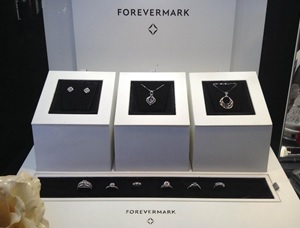
For those of you who haven’t heard of De Beers, they used to control the world’s diamond supply (and indirectly, control prices) up until the 1990s because of their huge mining operations.
When new mines were discovered around the world, the diamond supply market was changed completely as newer players entered the global mining industry.
As a result of increasing competition and political changes, De Beers core business of selling rough diamonds became affected. In a smart corporate move, De Beers created the Forevermark brand to diversify their business into the retail industry. Interestingly, De Beers chose to position Forevermark as a luxury product brand to compete against well established brands like Tiffany and Cartier.
In May 2008, Forevermark was officially launched by the De Beers Group of Companies. Since its inception, Forevermark had experienced phenomenal business growth. Today, Forevermark has become a global brand with a huge consumer reach. Through partnerships with large jewelry chain businesses, Forevermark diamonds are now sold in thousands of retail stores across different countries in the world.
In this review of Forevermark diamonds, we decided to take a closer look at whether they stand up to the marketing hype surrounding the brand.
What Is a Forevermark Diamond?
On their website, Forevermark promises their consumers that their diamonds are beautiful, rare and ethically sourced. They even claim that less than 1% of the world’s diamonds have the eligibility to become a Forevermark diamond.
From the way the ForeverMark diamond is described, it may sound like a big deal. In reality, it is largely a well crafted marketing campaign. You see, with the Kimberly Process and strict custom laws in place, it would be extremely difficult to find a conflict diamond even if you wanted to buy one.
And if you think about it logically, just about any other diamond you see in reputable stores can be just as rare, beautiful and ethically sourced. In this context, De Beers’s diamonds aren’t really that special or different.

Perhaps the highlight of Forevermark’s marketing tactics lie in the Forevermark inscription which is performed using “highly confidential patented technology”. Unlike the usual laser inscription process used by gemological labs like GIA, the Forevermark inscription is only 1/20th of a micron deep and is found on the table facet.
From a consumer’s point of view, the inscription doesn’t make the diamond more beautiful or change it in any discernible manner. From a practical perspective, the identification mark isn’t any much different from those typically inscribed into the diamond’s girdle using lasers. The main point about doing this boils down to marketing.
In fact, the president of Forevermark U.S., Charles Stanley, mentioned that the inscription is part of a product branding and I quote “the Forevermark inscription fundamentally is the visualization of the promise — it is a key part of the brand to help the salesman with the sale.”
What Kind of Quality Would You Find in Forevermark Diamond Rings?
First of all, I strongly encourage you to read through the marketing material that De Beers created for the ForeverMark diamonds at this link. If you pay a little attention to what they say in their promotional material, you will actually find some contradicting statements that will leave you scratching your head.
For example, in their “Diamond Buying Guide”, De Beers even tells you that a diamond must have very specific angles and proportions in order to maximize sparkle. Yet, the irony is that many of the ForeverMark diamonds aren’t cut to great proportions and they allow stones with “Very Good” cut ratings to make it pass their quality control process.
Here’s an example of a Forevermark round diamond which is cut to overly deep proportions and will impact the diamond’s performance. By light physics, the extremely steep pavilion angles (41.7) will also adversely impact light return.
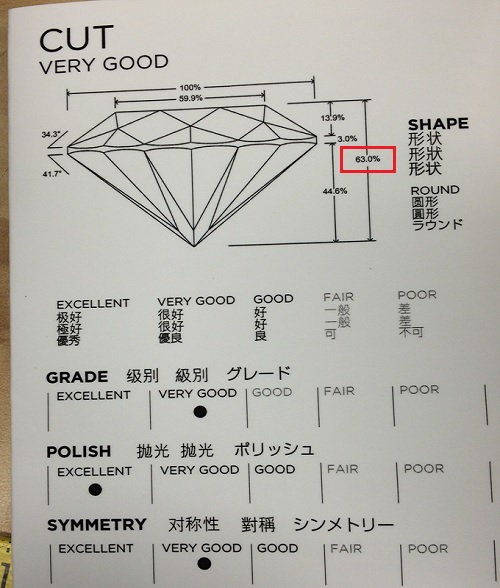
Besides experiencing light leakage, this diamond faces up smaller because weight is hidden from view in the face-up appearance. And to state the obvious, a Very Good cut diamond doesn’t offer you maximum sparkle or performance.
Interestingly, De Beers also claims that less than 1% of the world’s diamonds are eligible to become a Forevermark diamond. Naturally, you would expect a strict selection criteria similar to those imposed by high-end boutique stores like Harry Winston (D – E color and VS2 or better clarity) or Tiffany (D – I color and SI1 or better clarity).
Instead, Forevermark’s quality standards dictate that their diamonds must be at least 0.14 carats in size, above an L color, above an SI2 clarity and a cut grade of Very Good or better. Yep… You didn’t read that wrong nor did I make any typo errors. Forevermark allows diamond colors all the way down to L which means your diamond will show a tinge of yellow if you decide to get a diamond in the lower tiers.
Just to be clear, I have nothing against buying warm colored, tinted or lower clarity diamonds. The point I am making here is that diamonds with lower color/clarity combinations aren’t top-tier and shouldn’t be considered rare in the context of rough supply.
Don’t believe me? All you need to do is to quickly search online or visit your local jewelry store and ask how many D/IF diamonds they have as opposed to H or I colored SI1 diamonds.
Certificates Issued By De Beers’s Forevermark Diamond Institute
I got a shock when I first saw the Forevermark grading certificates in a local jewelry store. For a brand who’s building a luxury status in the mindset of consumers, I didn’t expect the grading report to look like a piece of plain white corrugated cardboard.
Initially, I thought it was a duplicated copy of the grading report until the sales person told me that it was indeed the original copy. Here’s how a Forevermark certificate looks like:
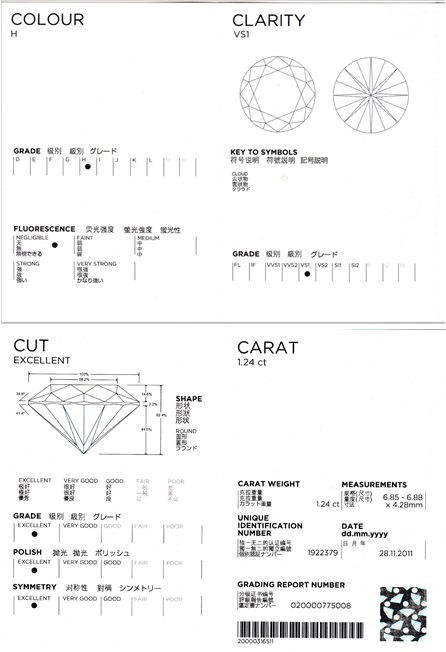
Aesthetic reasons aside, the more important point I want to highlight is that Forevermark diamonds are graded by De Beers’s Forevermark Diamond Institutes.
Instead of sending diamonds to neutral 3rd party labs like GIA or AGS, the diamonds are graded by De Beer’s own Forvermark Diamond Institutes. If you had read my article on the importance of independent certification, you will know that I have no love for such practices.
To be fair, I haven’t been able to critically examine a large sample size of loose Forevermark diamonds under laboratory grading conditions. As such, I cannot verify the kind of standards Forevermark is using or how well their standards compare against GIA’s. At the end of the day, the onus is on you to trust what the seller claims the diamond to be with their grading report.
Price Comparisons And The Huge Premiums You Can Expect to Pay
Forevermark diamond rings can usually be found at larger jewelry retail establishments. If you want to know how much additional premium Forevermark charges, you can easily perform your own price comparisons using online vendors as a benchmark. Here’s a couple of comparisons I made…
Blue Nile vs. Forever Mark
In the first lineup, I found a 1.51 carats Firemark princess cut diamond mounted in a white gold solitaire setting at King Jewelers. The ring costs a whopping $17,700. Interestingly, this diamond also has a GIA grading report on top of the in-house Forevermark certification document.
At Blue Nile, I managed to find a slightly larger princess cut diamond of 1.57 carats with a clarity grade of VS2 as well. The price for the loose diamond alone is only $9,092. To complete the ring, I selected a similar looking cathedral platinum prong setting which costs $990.
The total cost for a similar looking ring at Blue Nile is only: $10,082. That’s a savings of more than $7,600 and you also get a higher quality diamond (better symmetry/polish ratings and strong light return)!
White Flash vs. Forever Mark
In the next line up, I selected Forevermark’s signature “Center of My Universe” ring design for the comparison. At King Jewelers, I found a “Center of My Universe” listing with an F color VS2 clarity center diamond. The retail price for the halo ring is $9,460.
At White Flash, one of my recommended vendors for buying ideally cut diamonds, I found an exceptionally well-cut round brilliant diamond with the following specifications:
For the ring setting, I selected a premium Ritani setting which features a pave halo and rows of accent diamonds on the shanks.
In total, the completed halo ring would only cost: $4,018 + $1,990 = $6,008. Bear in mind that you are getting an extremely well-cut diamond which only exists in the top 1% of the entire market of polished stones. Unlike Forevermark’s marketing claims, the WhiteFlash diamond is backed up by tangible and scientific data of its precise cut quality.
James Allen vs Forever Mark
For the next comparison, I selected a 14 karat yellow gold solitaire diamond ring from Forevermark. The ring has a round brilliant cut center diamond weighing 0.50 carats and retails for $2,795 at Days Jewelers.
In contrast, a well-cut GIA triple excellent G color SI1 diamond from James Allen only costs $1,430. If you add in a 14k yellow gold solitaire setting which costs $390, the total price for the ring is only: $1,430 + $390 = $1,820
Compared to the Forevermark diamond ring, the James Allen ring is 35% cheaper! And this is despite the fact that you may actually receive a diamond of lower quality (e.g. H color SI2) with the Forevermark option.
Who Should Buy Forevermark Diamond Jewelry?
Well, if you have too much money to spare or like buying branded goods for the feel good factor, Forevermark might be the jewelry brand for you. Do note that Forevermark charges a premium that is on par to big brands like Cartier or Tiffany. However, the main difference is that their brand recognition isn’t on the same level as Cartier and Tiffany in the eyes of the general public.
Also, if there are certain Forevermark jewelry setting designs that you like, it is very unlikely for you to find an identical design elsewhere (due to copyright issues). In this case, shopping at Forevermark would make sense even though the prices are expensive.
Verdict on Forevermark Diamond Rings
In terms of marketing, Forevermark receives a 2 thumbs up from me. Their catchy slogans and clever word play with “forever” and “promise” is ingenious. After all, De Beers is the same company who created the most successful marketing campaign in history to make us believe diamonds are romantically associated with love. Honestly speaking, I wouldn’t expect anything less.
In terms of diamond quality, you get a mixed bag with the Forevermark brand. Sure, it is possible to find ideally cut diamonds in their inventory but you will have to be extremely selective of your choices.
Given the vast variance of diamonds with Very Good to Excellent cut grades and Good – Excellent symmetry/polish ratings, they may not be the best place to shop for diamonds if you are a discerning shopping who expect nothing but the best.
Related Articles
Leave A Comment

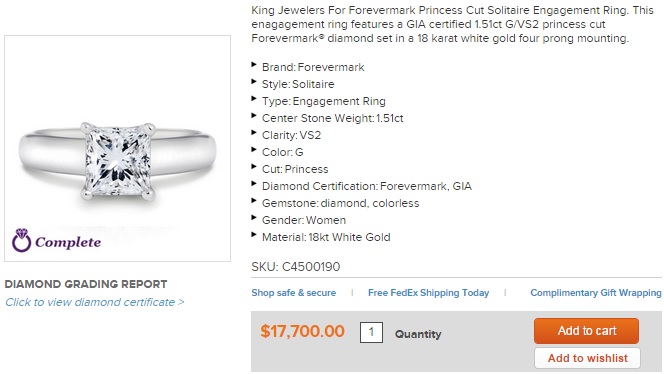
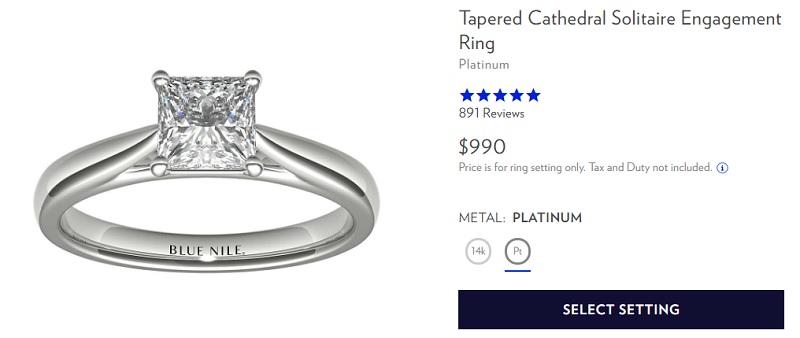
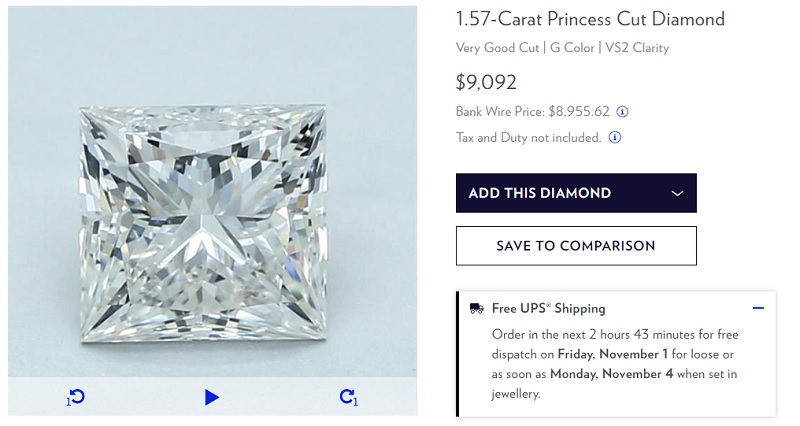
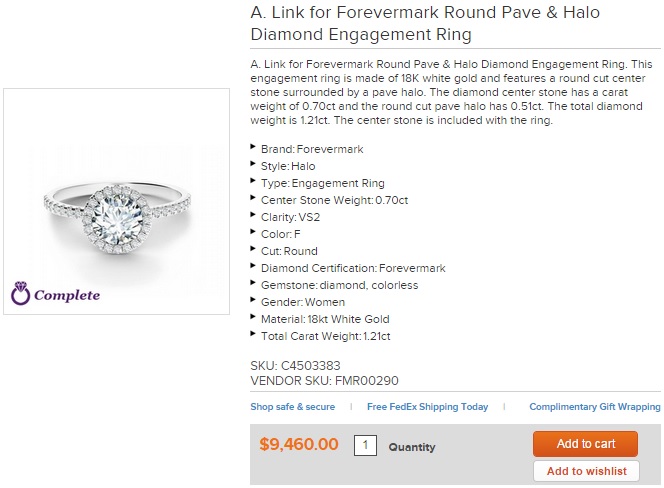
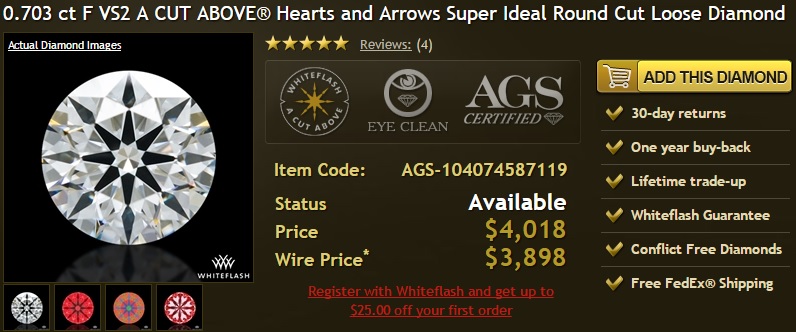
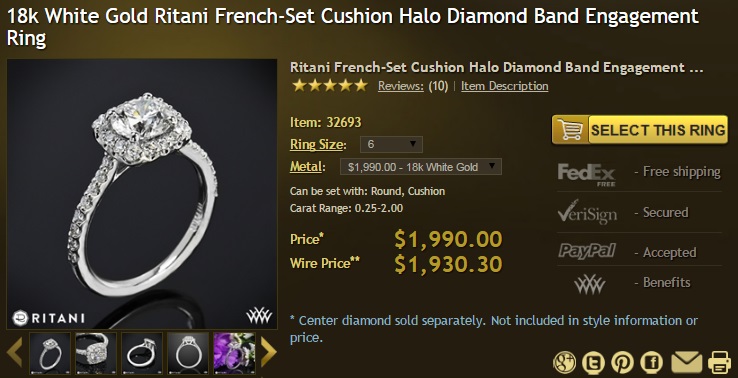
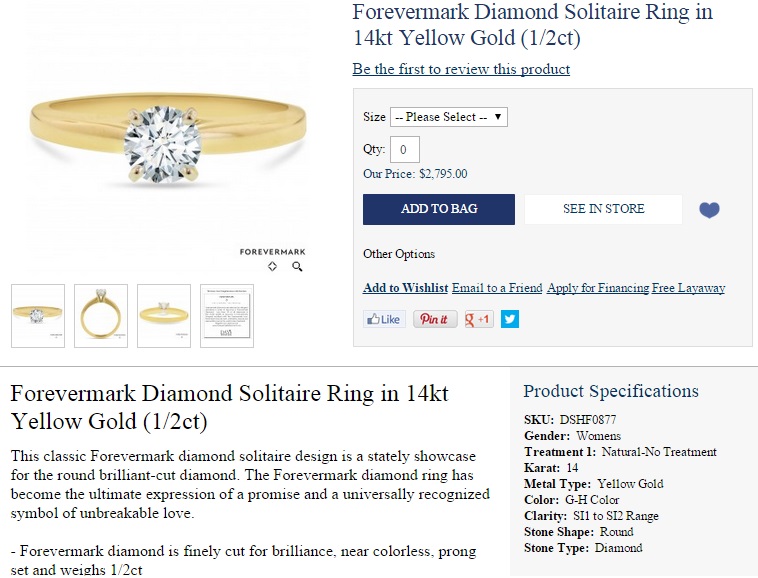
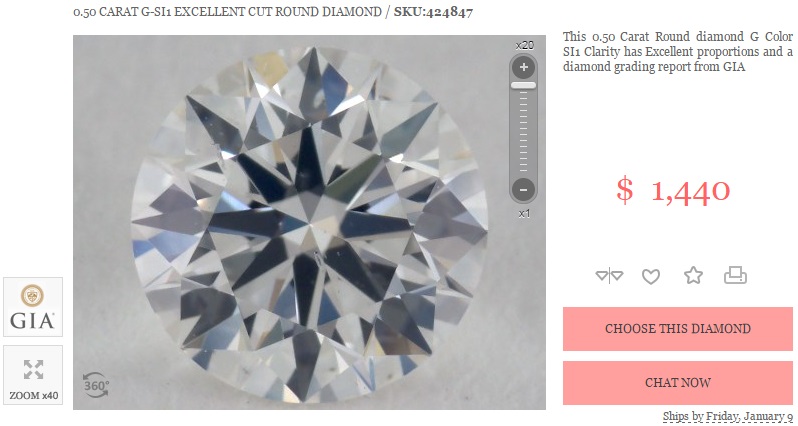
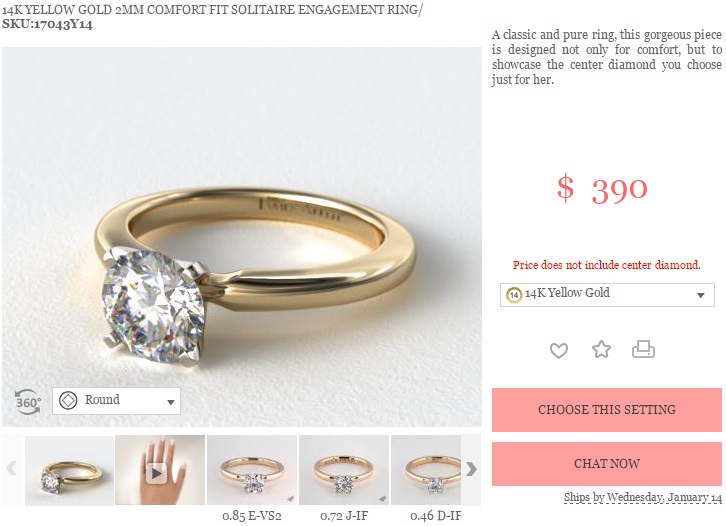
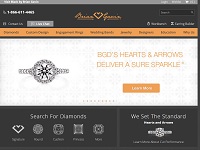
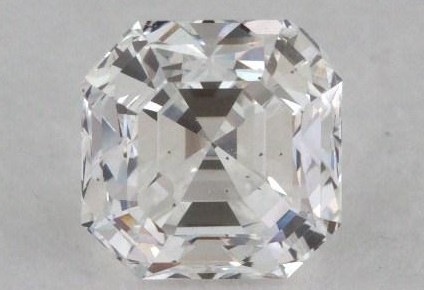

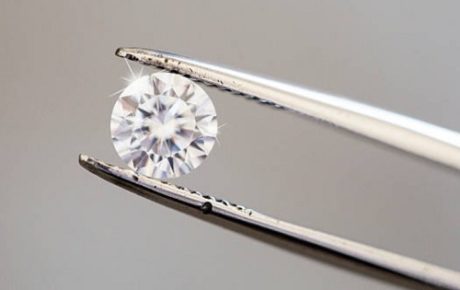









20 Comments
Recently, a local jewellery store quoted a 1.00 carat Forevermark ring for 10,600 EUR. When I did more research and read your review, I found that it is cheaper to buy online instead of buying locally.
The prices for Forevermark are marked up quite steeply. Also, if you are based in the UK or EU, jewelry is going to be more expensive because of the VAT and any other applicable taxes. In local stores, any applicable taxes are usually included in the prices you see.
Now, the prices I listed in this review are based on US purchases. Bear in mind that if you shop online and get the purchased shipped to your country, the purchase will need to be subjected to any local taxes. That said, in most cases where I help EU based readers make a diamond ring purchase online, the final price is still cheaper than what they have to pay locally.
All debates of pricing aside, this post and the comparisons provided are really useful. When shopping around it only makes sense to understand what value one is obtaining and what price is for diamonds is acceptable.
Hi,
I would like to purchase the forever diamond in india. Please let us know why online price is lower than the showroom’s. Is the certificate from forevermark vs gia report better or worse?
Regards
Raajesh
I’m not sure what you are referring to. As far as I know, Forevermark doesn’t retail their products directly to consumers via the Internet. You need to go to an authorized dealer to purchase them: http://www.forevermark.com/en/store-finder/
Between forevermark vs gia certificates, I would trust GIA’s grading standards and neutrality more.
Right on the money Paul. Pure Marketing scam. These forever mark stones are of lower quality than I would normally purchase, but the price says that they are better. Industry standard stones with an expensive marking technique. I would prefer my stones with no marks from DeBeers or GIA. Marked or made more imperfect doesn’t interest me at all. Marketing play seems really good for inferior stones. I will never buy these stones.
First of all, I respect the marketing techniques that De Beers use in their advertisements and had never mentioned that it’s a scam. De Beers charges a huge premium for their branding just like Tiffany and Cartier. There are some people who see value in purchasing “luxury” products for societal reasons.
I have one question. Paul, are you a GIA Graduate Gemologist?
Not yet. I completed the GIA Diamonds Graduate and intend to complete the GIA Graduate Gemologist course in 2016.
My de bear diamond was lost while I was in surgery. I cannot find my papers. Is there any way I can get duplicate papers so I can prove to the person responsible what the price of the ring is? What’s an estimated 1.5 carat forevermark diamond price in today’s market?
You may want to visit a store and check out a 1.5 carat forevermark diamond price for yourself. I can’t provide an estimate as there are too many moving parts and factors that affect a diamond’s value like color/clarity/cut. Even the setting itself would also affect its value. You should probably contact the jeweler you bought the item from. Don’t get your hopes high though. Any “valuation” documents that were provided at the point of sale were probably too high to begin with. Good luck!
I completely disagree with your review. I have been comparing the GIA certificate against Forevermark and to tell you the truth Forevermark’s is way better than the ugly, easy to forge GIA reports. Forevermark’s certificate has a hologram on the hard carbon paper certificate and it comes with barcoding, and a hard plastic card with a chip compared to a debit card that can be inserted in the reading machine at any forevermark store in the world. They spent two hours with excellent service in a private room only for me to freely compare the quality of the diamonds with a manual magnification scope and a digital microscope so I could easily see each inclusion or imperfections the certificate was mentioning.
Also, there are many more details in the forevermark certification than in the GIA’s. I also found that many of their certificates are also signed by GIA’s graduated gemologists. I was also able to see their laser inscription even with a diamond already set in a mount. This is great because you can always check it is still your diamond after doing any maintenance to the ring in any place in the world. This is not possible with the laser inscriptions done in some GIA diamonds on the side on the girdle surface because this is almost never visible once the diamond is set into the mount.
I was also able to compare some of their diamonds that also had GIA certification and I saw in a few cases their certificate had lower grades than what GIA was saying. I didn’t found any where the GIA was giving a lower grade. Most of them were matching the grading.
Finally, even Tiffany’s have their own certification process, and they claim it is much better than GIA’s. However, they hire GIA and AGS graduated gemologysts to grade their stones. If I compare a Tiffany’s certificate against a Forevermark, it has much less details, nice professional looks, and much fewer features than Forevermark’s. If you just feel and look at a Forevermark certificate, and compare its contents against the actual stone on a microscope, which they allowed me to do, you can see all the details that match with their report. I also liked that for Canadian Diamonds, they also mention the mine and provide you with the Canadian government additional certificate.
You probably need to view more diamonds and shop around. Who gave you the idea that the laser inscriptions in a GIA diamond cannot be viewed once it is mounted correctly? Here’s a word of advice, you should be comparing the cut quality of diamonds objectively. Are forevermark diamonds worth it from the perspective of a consumer? Well, it depends on what they want. When it comes to branding, Tiffany and Cartier are stronger brands. When it comes to prices, there are plenty of other jewelers who offer better cut quality at less than half the exorbitant prices Forever Mark diamonds are being sold.
Paul, I’ve been in the diamond business for 37 years and I’ve had the opportunity to compare tens of thousands of diamonds in my lifetime. I am a gemologist and member/associate of some of most prestigious associations for jewelers like GIA, AGS, Diamond Council of America, Jewelers of America, JVC, and NAJA, to name a few.
Since the 1930s, the Debeers company has been the main diamond miner. In fact, 90% of the diamonds in the market were mined by them. They choose the top 1% of the rough diamonds to be cut at the highest standards and be used by them. They laser imprint each and every one of their diamonds with a serial number, so you can track them and make sure they are legitimate diamonds and not synthetic, as synthetic diamonds have been entering the market recently and fooling the average consumer.
1% of that 1% of those rough diamonds are selected to be used for their signature Black Label. Only 17 cutters in the world are qualified/experienced to cut these diamonds because they are higher than excellent ideal cut.
It is true that their diamonds are not graded by a third party like GIA certified diamonds, but that does not make them less legitimate. In fact, their grading system is the same and fair, and their diamonds are certified by GIA certified gemologists as well.
All Forevermark diamonds are guaranteed to be responsibly sourced. That means no child labor or abuse of workers. In fact, they are committed to their community. They have helped build hospitals and schools, and have trained local people in new crafts.
I invite you to go to a Forevermark partner/authorize retailer and compare for yourself, you will be amazed.
Since you are in the trade, I presume you should know better. The fact that you mentioned “GIA certified gemologists” is pretty alarming because GIA doesn’t certify anyone or any diamonds.
Quote: “GIA does not certify its graduates” – https://4cs.gia.edu/en-us/blog/appraisal-tips/
Anyway, I had seen quite a few in person on many occasions. All I can say is I’m not impressed with the majority of their inventory considering how I’m used to seeing truly well cut diamonds all the time. Objectively, when I see cut grades below “Excellent” and the low bottomline color/clarity ratings for polished diamonds, it begs the question: why would you allow diamonds with cut ratings of Very Good when the Excellent range is the top tier?
https://www.forevermark.com/en-us/our-diamonds/beyond-the-4cs/cut/
Here’s just one of the many I had came across:
Cutwise, this diamond is not at the bottom of the barrel but it is definitely far from being the best of the best. That said, I need to reiterate that it is possible to find well cut Forevermark diamonds. You just need to know exactly what to look out for and do a bit of legwork to cherry pick the better stones.
Hi Paul,
Thank you for all of the information on your site and the informative forevermark diamonds reviews. It has been so helpful!
I’m in the market for an oval, and I wanted to ask you about the newer “Black Label” branding from Forevermark, which supposedly adds arrows to fancy shape diamonds. Are forevermark diamonds good for fancy shapes? Have you had the chance to view any of these, and if so, what is your take on their light performance versus a normal brilliant oval?
Unfortunately, I haven’t had a chance to see a Black Label oval diamond from De Beers yet. What about yourself? Did you manage to see any and compare them in person?
I was able to see one, but was only able to directly compare against one other oval and I do not recall the cut quality of that other stone. The Black Label displayed a noticeable fire and sparkle compared to other ovals I have viewed, though with this particular one, I was concerned with the stone looking dark (gray/blueish). I was wondering if it might be due to the larger overall depth and/or the fluorescence. I will try emailing you the specs if you wouldn’t mind taking a look.
Really appreciate your article – I’m looking to buy an engagement ring, and have been working with my cousin, who is in the jewelry business. She absolutely swears by Forevermark, but I doubt she has the same breadth of knowledge that you have regarding this topic (not sure she’s a GIA graduate of anything)… it seems like forevermark is offering a self proclaimed pristine product with an enormous premium. She’s quoting me a 0.9ct K/VS2 and “beyond ideal” cut cushion diamond for $5000 – when I can find similar cuts and 4C graded diamonds online for less than half that price.
My question is – are these forevermark diamonds just an elite luxury item that make little to no difference with the lay people? I think I’d be fine with a 1.0ct G/VS1 from James Allen for $3000 than deal with this insanely overpriced forevermark program to buy a diamond that may be marginally (if not even distinguishable) more brilliant. Is my interpretation correct?
I think you hit the nail on the head. With Forevermark diamonds, you are paying an insane premium and that’s on the assumption that you are even getting a well cut cushion diamond in the first place.